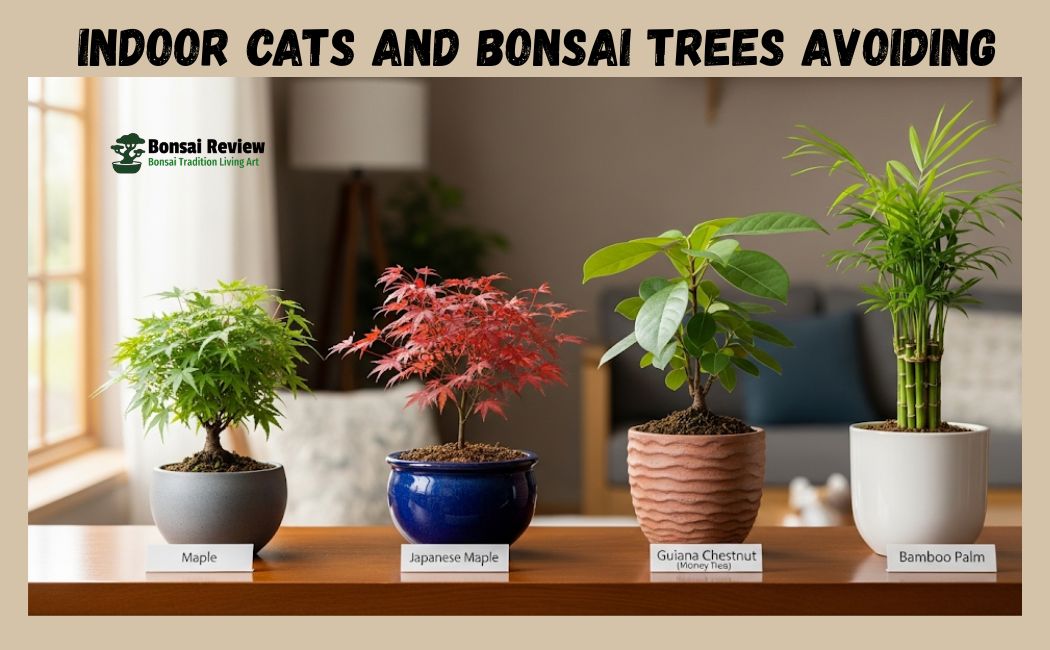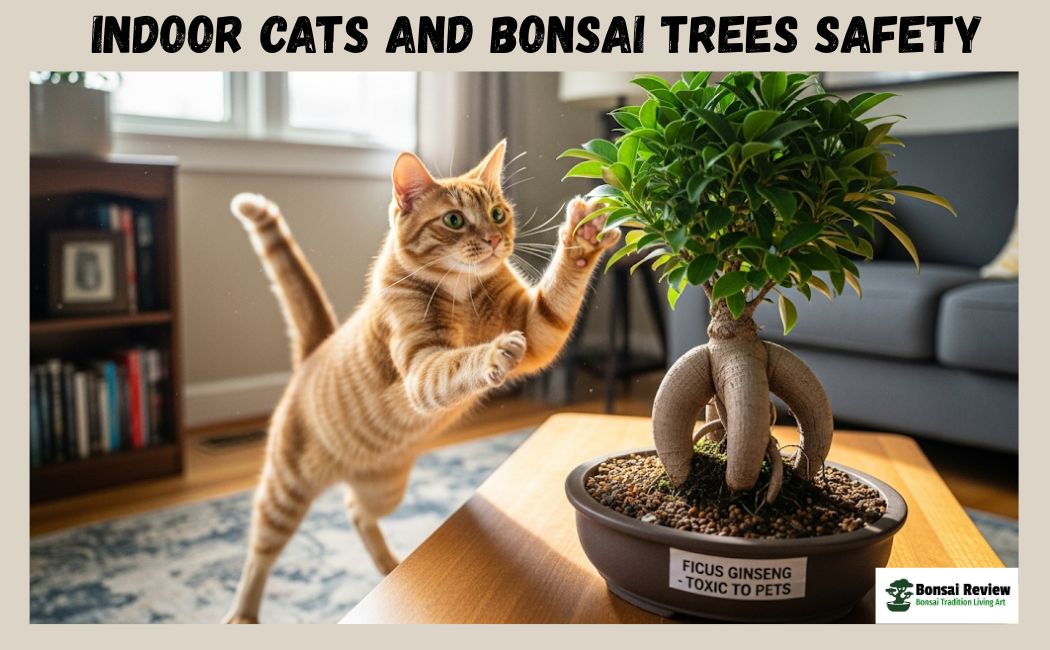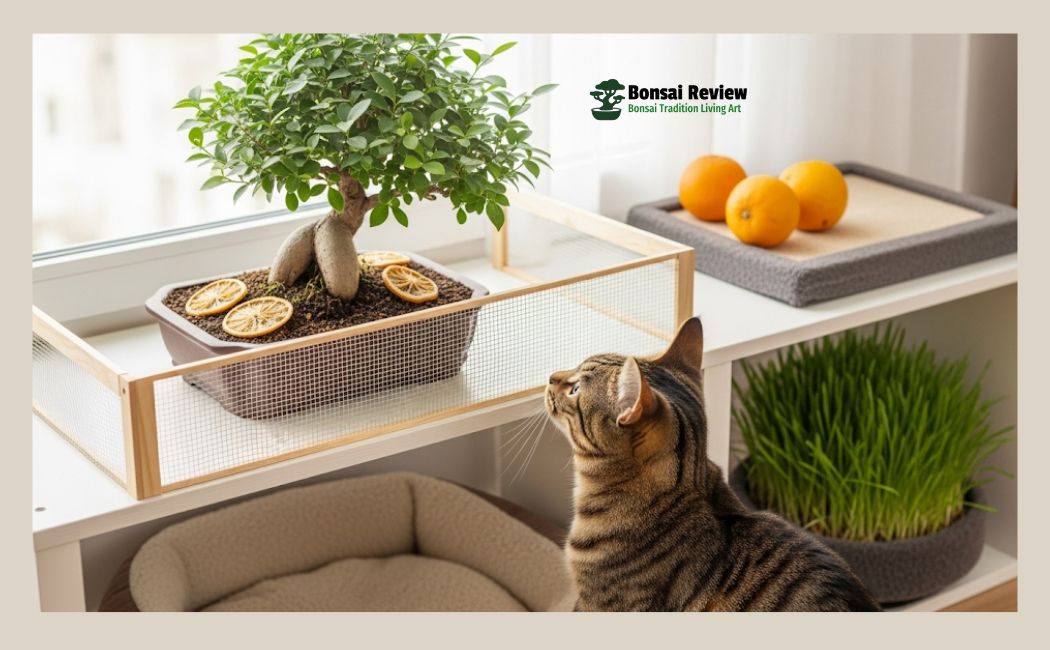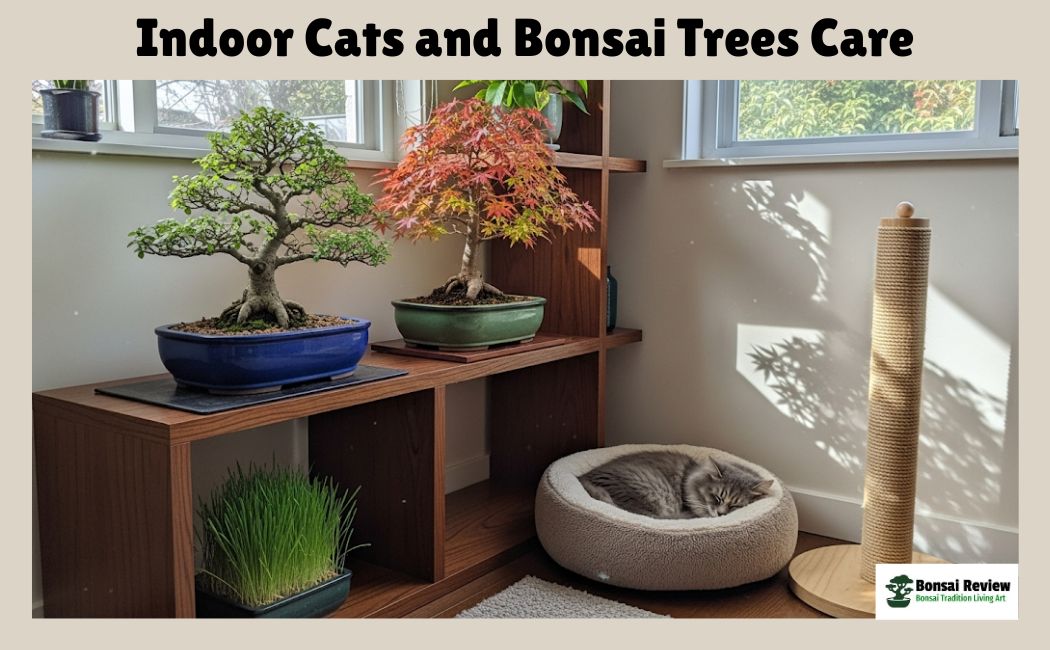Indoor Cats and Bonsai Trees: When you keep indoor pets and want to grow a bonsai tree, you face a tricky problem. Pets are curious by nature, and many bonsai species like the Ficus ginseng (Ficus microcarpa), Tiger bark, Tea tree, and Jade bonsai are toxic to pets. If your cat chews on these leaves, it may suffer from vomiting, drooling, or stomach pain.
On the other hand, Indoor Cats and Bonsai Trees, such as the Chinese elm, Maple bonsai like a Japanese maple, or the Guiana Chestnut, are considered non-toxic and let you enjoy your tree without fear.
The challenge is not only about toxicity. Cats may jump on tables, dig into the soil, or even use the bonsai pot like a litter box. This can harm both your pet and your tree. The good news is, there are simple solutions.
By choosing non-toxic bonsai trees for cats, placing your tree in a safe spot, and giving your pet a cozy cat bed, a playful cat scratcher, or even some cat grass to chew, you can protect both.
Add small deterrents like citrus scents or a gentle spritz of water, and your cat will quickly learn to avoid your bonsai. With the right balance of care and planning, you don’t have to pick between your love for bonsai and your love for your cat.

Are Bonsai Trees Toxic to Cats?
Not all bonsai species are safe for your pets. Some contain natural toxins like saponins, glycosides, or alkaloids that can make cats very sick if ingested. If your cat chews a leaf from a toxic bonsai, symptoms may include vomiting, drooling, loss of appetite, or lethargy.
Because of Indoor Cats and Bonsai Trees, it’s vital to know which bonsai are toxic and which are non-toxic before placing one in your home. Here’s a simple guide:
| Bonsai Type | Scientific Name | Toxic or Non-Toxic | Effect on Cats |
| Ficus ginseng (Tiger Bark Ficus) | Ficus microcarpa | Toxic | Causes drooling, vomiting, and stomach upset |
| Jade Bonsai | Crassula ovata | Toxic | Leads to lethargy, vomiting, and incoordination |
| Tea Tree Bonsai | Melaleuca alternifolia | Toxic | Can cause weakness, tremors, and liver issues |
| Sago Palm Bonsai | Cycas revoluta | Highly Toxic | Severe liver failure, life-threatening |
| Chinese Elm | Ulmus parvifolia | Non-Toxic | Safe, considered cat-friendly |
| Maple Bonsai (Japanese Maple) | Acer palmatum | Non-Toxic | Safe choice for indoor cats |
| Guiana Chestnut (Money Tree) | Pachira aquatica | Non-Toxic | Cat-friendly, often used indoors |
| Parlor Palm / Bamboo Palm | Chamaedorea elegans / Chamaedorea seifrizii | Non-Toxic | Safe and pet-friendly |
| Juniper Bonsai | Juniperus spp. | Mild Risk | Not highly toxic, but ingestion may cause upset stomach |
If you want a bonsai that’s safe for cats, stick to Chinese elm, Maple bonsai, Guiana Chestnut, or Palms. Avoid Ficus bonsai, Jade, Tea tree, and Sago palm, as these are harmful.

Why Cats Go After Bonsai Trees?
If you wonder why your indoor cat keeps attacking your bonsai tree, the answer lies in natural instincts. Cats are playful, curious, and sometimes bored. A bonsai in your living room looks like a new toy or even a snack.
- Chewing leaves: Cats may bite the leaves of a Ficus bonsai or Maple bonsai just to test the texture or taste. For kittens, chewing is part of exploring.
- Digging soil: The soil in a Chinese elm or Juniper bonsai pot feels soft, like a litter box. Some cats dig Indoor Cats and Bonsai Trees out of habit.
- Climbing and knocking: Cats enjoy climbing and may jump on the shelf where your Guiana Chestnut or Ficus microcarpa is placed, risking a fall.
- Stress or boredom: Without a cat scratcher, cat grass, or a cozy cat bed, cats often turn to plants to release energy.
While the behavior is natural, Indoor Cats and Bonsai Trees create two dangers:
- Your bonsai gets damaged.
- Your cat may chew a toxic bonsai like Jade or Tea tree, leading to health risks.
Your cat isn’t trying to be naughty. Indoor Cats and Bonsai Trees follow instincts. By understanding the behavior, you can offer safe alternatives and prevent accidents.
Indoor Cats and Bonsai Trees: Safer Bonsai Choices for Pet-Friendly Homes
If you want both your indoor cats and your bonsai tree to stay safe, the best step is to choose a non-toxic bonsai species. Not every tree works well in a cat-friendly home, so knowing the safe and unsafe ones helps you avoid worry.
Best Non-Toxic Bonsai for Cats: Indoor Cats and Bonsai Trees
- Chinese Elm (Ulmus parvifolia) is hardy, easy to shape, and cat-friendly.
- Maple Bonsai (Acer palmatum), like the Japanese maple, offers beautiful seasonal color without toxicity.
- Guiana Chestnut (Pachira aquatica), also called the Money Tree, is safe for pets and brings good luck in many cultures.
- Palms Parlor Palm and Bamboo Palm are popular choices for safe indoor bonsai styling.
Bonsai to Avoid in Cat Homes: Indoor Cats and Bonsai Trees
- Ficus Bonsai (Ficus ginseng / Ficus microcarpa / Tiger Bark) – common in homes but toxic to cats.
- Jade Bonsai (Crassula ovata) is very popular but dangerous, and can cause vomiting and lethargy.
- Tea Tree Bonsai (Melaleuca alternifolia) has toxic oils harmful to cats.
- Sago Palm Bonsai (Cycas revoluta) is one of the most toxic plants and may cause liver failure in pets.
Indoor Cats and Bonsai Trees: If you’re unsure about a bonsai, always check if it’s toxic or non-toxic before bringing it home. Choosing the right species keeps your bonsai collection safe for both you and your cat.

How Can We Protect Bonsai from Curious Cats?
Even if you pick a cat-friendly bonsai like a Chinese elm or Guiana Chestnut, your cat may still chew, dig, or climb. That’s why placement and barriers are just as important as species choice.
1. Elevate the Bonsai
Keep your bonsai on high shelves, plant stands, or window ledges that cats cannot reach. Avoid placing a Maple bonsai or Ficus bonsai near furniture that works as a “launch pad” for jumping.
2. Use a Dedicated Room
If you have a special bonsai room, make it a pet-free zone. For example, keeping your Japanese maple or Juniper bonsai in a closed space with sunlight ensures both safety and healthy growth.
3. Add Physical Barriers
Decorative screens, glass domes, or mesh guards can separate a bonsai like a Tiger Bark Ficus from playful paws. You can also place stones or gravel on the soil surface to stop digging.
4. Consider Outdoor Placement
If your cats live indoors only, move non-tropical bonsai such as Chinese elm or Juniper to a patio or balcony when the weather is warm. Indoor Cats and Bonsai Trees, so your bonsai gets fresh air while your cat stays safe inside.
Protecting your bonsai is not just about safety. Indoor Cats and Bonsai Trees also help your tree grow without stress from constant pawing, chewing, or soil disturbance.
Providing Pet Alternatives: How to Prevent Chewing & Digging?
Cats often bother bonsai because they are bored, curious, or need something to chew or scratch. Giving your cat safe alternatives helps protect your bonsai tree and keeps your pet happy.
1. Cat Grass for Chewing
Place a small pot of cat grass near your cat’s favorite spot. It satisfies the chewing instinct, so your cat ignores the leaves of a Ficus bonsai or Maple bonsai.
2. A Cozy Cat Bed: Indoor Cats and Bonsai Trees
Cats love sunny spots. If your bonsai sits by a window, add a cat bed nearby. Your pet will choose the soft bed over the bonsai pot, leaving trees like your Chinese elm or Guiana Chestnut safe.
3. Cat Scratcher and Toys
Without a cat scratcher, your cat may dig into bonsai soil or knock over a Juniper bonsai while playing. Scratching posts, climbing trees, or toys give your cat a better outlet.
4. Multiple Distractions: Indoor Cats and Bonsai Trees
Mix options: catnip toys, tunnels, or perches. The more your cat has to do, the less it will care about your Tiger Bark Ficus or Japanese maple.
When cats have their own safe spaces and toys, they leave your bonsai alone. Meeting your cat’s needs is as important as protecting the tree.

Indoor Cats and Bonsai Trees Using Deterrents to Keep Cats Away
Even with safe bonsai species and alternatives, some cats are persistent. Using gentle deterrents can protect your bonsai without hurting your pet.
1. Citrus Scents
Cats dislike the smell of citrus. Placing orange, lemon, or lime peels near the bonsai pot or using a diluted citrus essential oil spray can naturally keep cats away from a Ficus ginseng or Tiger Bark Ficus.
2. Aluminum Foil or Pebbles on Soil
Sprinkle small pebbles or cover soil with aluminum foil. This makes digging unpleasant for cats while keeping bonsai like Chinese elm or Juniper bonsai intact.
3. Water Spritzer Training
A gentle spray from a water spritzer when your cat approaches the bonsai can create a negative association. Never spray directly on the cat; just mist near the tree. Over time, cats learn to avoid areas with Maple bonsai or Guiana Chestnut.
4. Combination Approach
For stubborn cats, combine barriers, alternatives, and deterrents. For example: place the bonsai on a shelf, add cat grass, and sprinkle citrus peels. This triple approach protects both the tree and the pet effectively.
Key Point: Using non-toxic, harmless deterrents helps your cat learn boundaries without stress, keeping your bonsai safe.
General Safety Measures & Monitoring
Even with safe bonsai species and deterrents, regular care is important to prevent accidents and protect your indoor cats.
1. Keep the Area Clean: Indoor Cats and Bonsai Trees
- Remove fallen leaves, twigs, or debris from bonsai soil.
- Clean the surrounding floor regularly to reduce attraction for digging.
- Ensure your cat’s litter box is clean; dirty litter can lead cats to dig in bonsai soil.
2. Monitor Your Cat’s Health
- Watch for symptoms like vomiting, drooling, lethargy, or loss of appetite.
- If a cat has ingested any toxic bonsai such as Jade, Tea Tree, or Ficus microcarpa, contact your veterinarian immediately.
- Regular check-ups help catch any issues early.
3. Inspect Bonsai Regularly
- Check the bonsai leaves and soil for signs of chewing or digging.
- Remove any damaged branches and ensure your bonsai remains healthy.
- Rotate bonsai placement occasionally to minimize your cat’s interest.
4. Safe Handling Practices
- Always wash your hands after trimming or repotting a bonsai.
- Avoid placing toxic bonsai species in areas your cat can reach.
Key Point: Consistent monitoring and cleaning reduce risks for your cat and keep your bonsai in top condition. Safety is a combination of placement, care, and vigilance.
Conclusion: Keeping Indoor Cats and Bonsai Trees Safe Together
You don’t have to choose between your love for indoor cats and your passion for bonsai trees. By understanding which bonsai species are toxic, like Ficus ginseng, Ficus microcarpa, Tiger Bark, Jade, or Tea Tree bonsai, and which are non-toxic and cat-friendly, such as Chinese elm, Maple bonsai, Japanese maple, Guiana Chestnut, or Bamboo palms, you can create a safe environment for both.
Placement matters: keep bonsai elevated or in a dedicated room, and use physical barriers or deterrents like citrus scents, aluminum foil, or gentle water spritzers to discourage curious paws. Provide alternatives like cat grass, a cozy cat bed, or a cat scratcher to redirect your cat’s natural instincts away from the bonsai.
Regular monitoring and cleaning ensure that your bonsai stays healthy and your cat remains safe, free from ingestion of toxic plants. With the right combination of safe species, proper placement, deterrents, and cat-friendly alternatives, you can enjoy both your feline companion and your beautiful bonsai collection without stress. Thoughtful planning and care allow your indoor cats and bonsai trees to coexist happily, creating a safe, harmonious, and aesthetically pleasing home.
Helpful article: Is Sedum Morganianum (Burro’s Tail) Poisonous to Humans or Pets?
FAQs: Safe Bonsai for Cats: Non-Toxic Trees Your Pets Can Live With.
1. Can cats be around a bonsai tree?
Yes, but only if the bonsai is non-toxic and placed safely. Trees like Chinese elm, Maple bonsai, Japanese maple, Guiana Chestnut, or Bamboo palms are safe for cats. Use high shelves, dedicated rooms, or barriers to prevent accidents.
2. Are bonsai trees harmful to pets?
3. Are Juniper bonsai trees safe for cats?
Juniper bonsai is generally mildly risky. Small amounts are usually not dangerous, but ingestion may cause stomach upset. Monitor your cat and use deterrents if needed.
4. Are Ginseng bonsai trees toxic to cats?
Yes. Ficus ginseng (Ficus microcarpa / Tiger Bark) is toxic and can cause drooling, vomiting, and digestive upset if chewed. Keep it out of reach of cats.
5. Are Chinese Elm bonsai trees poisonous to cats?
No. Chinese elm bonsai is non-toxic and considered cat-friendly, making it a safe choice for homes with indoor cats.
6. Are bonsai trees hard to take care of?
Bonsai require regular watering, pruning, and sunlight, but choosing hardy, cat-safe species like Chinese elm or Maple bonsai makes care easier and safer for pets.
7. Are bonsai trees toxic to dogs?
Some bonsai species are toxic to dogs as well, including Ficus ginseng, Jade, Tea Tree, and Sago Palm. Always check species toxicity before placing bonsai in homes with pets.